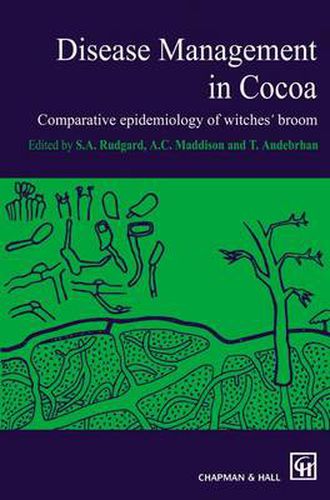Readings Newsletter
Become a Readings Member to make your shopping experience even easier.
Sign in or sign up for free!
You’re not far away from qualifying for FREE standard shipping within Australia
You’ve qualified for FREE standard shipping within Australia
The cart is loading…






This title is printed to order. This book may have been self-published. If so, we cannot guarantee the quality of the content. In the main most books will have gone through the editing process however some may not. We therefore suggest that you be aware of this before ordering this book. If in doubt check either the author or publisher’s details as we are unable to accept any returns unless they are faulty. Please contact us if you have any questions.
Witches’ broom is an important Southern and Central American disease of cocoa that is estimated to reduce annual world production by some six to seven percent. The disease is still spreading into currently unaffected cocoa-producing areas. There is a risk that the pathogen, Crinipellis perniciosa, may one day spread into the major cocoa-producing areas of West Africa and South East Asia, whose economies are at times almost completely dependent on exports of cocoa. This book describes the results of an authoritative, international study resulting from collaboration among plant pathologists in South America and the Caribbean with centres of expertise in the USA and UK. The experimental programme was directed towards the development of practical, reliable and economic methods of managing witches’ broom disease in a number of cocoa-growing environments. To achieve this, a series of comparative experiments under different climate and disease pressure conditions was established in six countries. Experimental methods, the resultant comparative analyses and the conclusions drawn are described in the book. The project could serve as a future model for study of both temperate and tropical pathogens and the book should therefore be of interest to plant pathologists in general, as well as those with specific interests in cocoa pathology. In addition, it should appeal to students of epidemiology and technicians faced with similar pathology problems. This book should be of interest to students in epidemiology; plant pathologists in general, as well as those with specific interests in cocoa pathology.
$9.00 standard shipping within Australia
FREE standard shipping within Australia for orders over $100.00
Express & International shipping calculated at checkout
This title is printed to order. This book may have been self-published. If so, we cannot guarantee the quality of the content. In the main most books will have gone through the editing process however some may not. We therefore suggest that you be aware of this before ordering this book. If in doubt check either the author or publisher’s details as we are unable to accept any returns unless they are faulty. Please contact us if you have any questions.
Witches’ broom is an important Southern and Central American disease of cocoa that is estimated to reduce annual world production by some six to seven percent. The disease is still spreading into currently unaffected cocoa-producing areas. There is a risk that the pathogen, Crinipellis perniciosa, may one day spread into the major cocoa-producing areas of West Africa and South East Asia, whose economies are at times almost completely dependent on exports of cocoa. This book describes the results of an authoritative, international study resulting from collaboration among plant pathologists in South America and the Caribbean with centres of expertise in the USA and UK. The experimental programme was directed towards the development of practical, reliable and economic methods of managing witches’ broom disease in a number of cocoa-growing environments. To achieve this, a series of comparative experiments under different climate and disease pressure conditions was established in six countries. Experimental methods, the resultant comparative analyses and the conclusions drawn are described in the book. The project could serve as a future model for study of both temperate and tropical pathogens and the book should therefore be of interest to plant pathologists in general, as well as those with specific interests in cocoa pathology. In addition, it should appeal to students of epidemiology and technicians faced with similar pathology problems. This book should be of interest to students in epidemiology; plant pathologists in general, as well as those with specific interests in cocoa pathology.